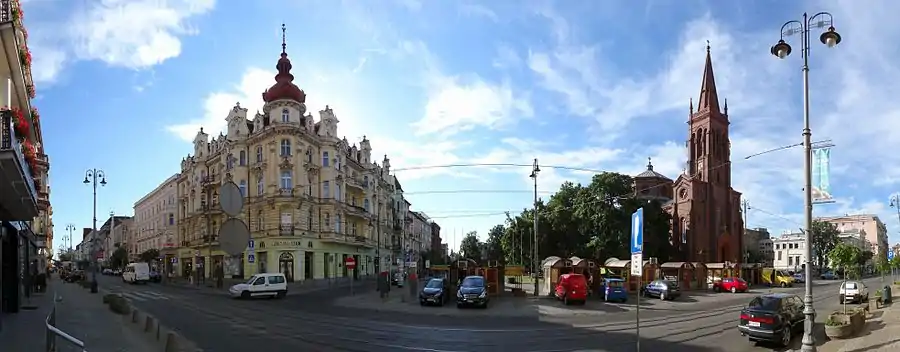 Bird eye view of Freedom Square Bydgoszcz | |
_1939.jpg.webp) Location of Freedom Square on a 1939 map | |
| Native name | Plac Wolności (Polish) |
|---|---|
| Former name(s) | Weltzien Platz (till 1920 & 1939–1945) – Plac Wolnosci (1920–1939) & after 1945 |
| Location | Bydgoszcz, |
Freedom Square in Bydgoszcz (Polish: Plac Wolności) is located in Bydgoszcz, Poland, in downtown area, between Gdańska Street and the park Casimir the Great.
Characteristics and Location
Freedom Square stands as an elegant place of Downtown district (Polish: Śródmieście) of Bydgoszcz, ornamented by Art Nouveau buildings, a historical church, a memorial and a green park. This is a location for recreational activities as well as military and official ceremonies.[1]
The square is centrally located: on its western edge runs the Gdańska Street, heart of downtown Bydgoszcz. On its south border is the Casimir the Great Park, and to the east starts north the Gimnazjalna street.
History

The land square was formerly part of the garden of 17th century monastery "Sisters of the Poor Clares", along with the area of today's park Casimir the Great. In 1835, the Bydgoszcz City Beautification Society ((in German) Verschönerungs – Verein zu Bromberg) founded on the east side of Gdańska Street a tree nursery tower grown to brighten up the eastern side of Gdanska Street. In 1854, a first and small square called the Place fodder (German: Kannonenplatz) existed. In 1859, the square was extended to the south and planted with trees and greenery, the entire project being financed by Major General Helmut Carl Christian von Weltzien. In 1860, the square was named in his honor (German: Weltzienplatz).[2] Nursery trees in the square still functioned for several years, however, their importance was gradually reduced to the benefit of surfaces on which were erected buildings, High School Nr.1 and a church.
Originally its shape was a large rectangular square, with streets dividing it into four quarters. In 1873, the southern part of the square was used for the construction of the Lutheran church of St Peter's and St Paul. On 17 September 1893 a statue of Emperor Wilhelm I on horseback was erected in the center of the square:[1] it was erected "in memoriam" of the deceased emperor, as a tribute to the creator of the German Reich and the father of the nation.[3] The monument was funded partly by the city, partly by donation from wealthy citizens, like among others, Lewin Louis Aronsohn or Heinrich Dietz.[3] This monument was short lived: after Bydgoszcz returned to Polish territory in 1919, the statue was dismantled and moved to the city of Meseritz (Międzyrzecz).[4]
Later, in 1904, on the fringe of the Municipal Park (now the Park Casimir the Great) was established the monumental sculpted fountain "The Deluge". It remained for 40 years the most attractive sculpture of the city and a symbol of downtown Bydgoszcz, before being partially dismantled and melted down by German forces.

During the interwar period, Freedom Square was one of the most charming and well-kept places in Bydgoszcz, embellished by carpets of flowers. In 1938, a reconstruction project run by engineer Stefan Pietrzak modified the appearance of the square: the area adjacent to Gdańska Street was converted into a parking lot, with a lawn area leading to the park Casimir the Great.
In 1945, a memorial to freedom has been by architect Jan Kossowski at the center of the square, in honor of Soviet and Polish soldiers – liberators of the city from Nazi occupation. The monument still exists today, yet it was rebuilt in 1991, adding the following words, "Civitas Bydgostiensis Libera". In 1995, a bronze bas-relief (by Aleksander Dętkoś) was fixed on the memorial, commemorating both the fight for independence of the Poles and the return of Bydgoszcz city to Poland on 20 January 1920.
During the Polish People's Republic, a cannon stood on the square, in honor of a lieutenant colonel of the Red Army, Grzegorz Ivanovich Bolshanin.[5] It was removed in 1964.
Architecture
The Freedom Square is enclosed by several different buildings on its northern front, several styles being represented, including Art Nouveau at Nr.3, Eclecticism at N.1 and 5, and Modern architecture at N.7. The neo-Romanesque St Peter's and St Paul's Church and the oldest city park lie on its southern border. The western side is delimited by Gdańska Street and Gimnazjalna street borders the east side.
Since 2004, restoration works have led to the recovering of the historic shape of the fountain "the Deluge", completed in 2014. In 2009–2010, a program of revitalization of the square has been carried out (alleys and greenery), together with a refurbishment of main facades.
Main locations and buildings
St Peter's and St Paul's Church registered on Kuyavian-Pomeranian Voivodeship heritage list, Nr.A/62, 5 October 1971.[6]
Built in 1872–1878, by Berlin architect Friedrich Adler: Eclecticism and Gothic Revival.
From 1878 to 1945, the temple was devoted to the congregation of the Evangelical Union. In 1945, it has been dedicated to Catholic liturgy, then to a parish church since 1946. Above the main altar stands a painting of the Immaculate Conception of the Blessed Virgin Mary (1850), by Maksymilian Piotrowski, inspired from the former Jesuit church standing at the very place.
-LCCN2002720699.jpg.webp) The church and the square ("Weltzin Platz") ca 1900
The church and the square ("Weltzin Platz") ca 1900 Statue of Emperor Wilhelm on Weltzienplatz square
Statue of Emperor Wilhelm on Weltzienplatz square View from Gdańska Street
View from Gdańska Street View from the foutain "Deluge"
View from the foutain "Deluge".JPG.webp) View of the nave
View of the nave
Tenement at Freedom Square 1
Registered on Kuyavian-Pomeranian Voivodeship heritage list, Nr.601429, Reg.A/1041 20 October 1990,.[6]
Built in 1896–1898 by Józef Święcicki: Eclecticism and Neo-Baroque.
One of the most famous works of Józef Święcicki, a fecund Bydgoszcz architect from the start of the twentieth century. The building is famous for its sophisticated design and the architectural forms of the facade. The corner tower is topped with a bulbous dome.
 View from Gdańska Street
View from Gdańska Street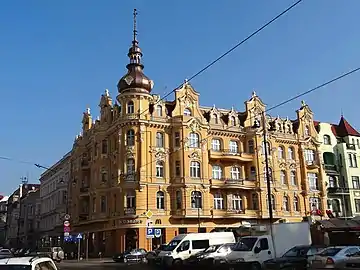 View of the facade on Freedom Square
View of the facade on Freedom Square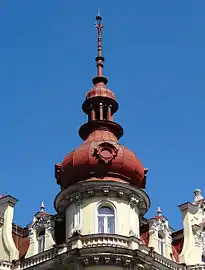 Detail of the corner spire
Detail of the corner spire
Tenement at 3 registered on Kuyavian-Pomeranian Voivodeship heritage list, Nr.oA/257/1, 6 May 1991.[6]
Built in 1903, by Fritz Weidner: Historicism and Polish secession.
The building was ordered by Carl Ruckenschuch, a merchant to Fritz Weidner,[7] as his family house.
The edifice has an asymmetrical façade, the way Weidner design other tenements (e.g. at Gdańska Street Nr.28, Nr.31 or Nr.34), with typical Art Nouveau motifs: feminine masks, owls and beehive. Interiors too have retained some Art Nouveau elements such as the stairwell with nice wall tiles. The plaque on the façade reminds people that in this building lived and worked Andrzej Nowacki for 50 years. A sculpture "Jeans Andrew" by Peter Wagner was unveiled in the 11th anniversary of the death of the artist, as a tribute to the Bydgoszcz art painter. "Jeans Andrew" refers to the artist's most famous cycle – "Udżinsowieni" whose main theme is blue pants. Jeans were for Andrew Nowacki symbol of the times, a symbol of freedom and youth, but on the other hand, is also a metaphor for submission to the fashion and cultural schemes.[8]
 View of the facade on Freedom Square
View of the facade on Freedom Square Detail of motifs
Detail of motifs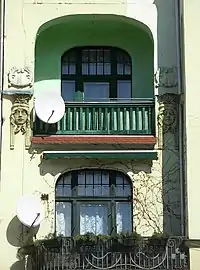 Detail of motifs
Detail of motifs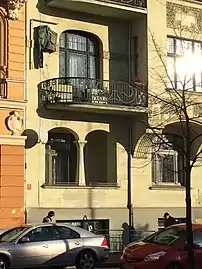 Detail of the facade with the "Jeans Andrew" art work
Detail of the facade with the "Jeans Andrew" art work
Tenement at 5, registered on Kuyavian-Pomeranian Voivodeship heritage list, Nr.A/278/1, 1 October 1991.[6]
Built in 1880–1890: Eclecticism.
The building still features nice interiors: plastered ceiling in the hallway and ancient stoves in some flats. The main entry corridor displays stuccoed pilasters and a multicolored terrazzo floor with geometric motifs.
.JPG.webp) Main facade view from the square
Main facade view from the square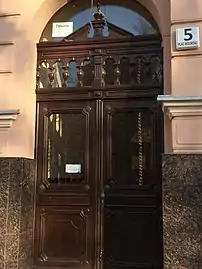 Detail of the gate
Detail of the gate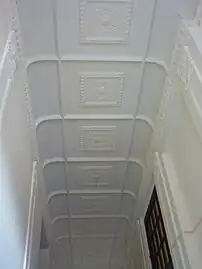 Hallway ceiling
Hallway ceiling
Tenement at 7, 1939, by Jan Kossowski: Modern architecture.
The house was built according to a design by architect Jan Kossowski, who designed also Freedom Monument standing on the square. It is an example of Polish modernism of the interwar period.[9] First owners of the building were an interior and furniture designer Jacob Hechliński, and the building designer Carl Meinhardt. The facade is clad with sandstone, and the glazed ground floor was originally occupied by a Chevrolet car dealer, Antoni Butowski.[10]
During the Polish People's Republic'time (PRL) it housed a cafe, "Magnolia". Wacław Gieburowski, conductor of the Poznan Cathedral Choir, was born there as mentioned on commemorative plaque.
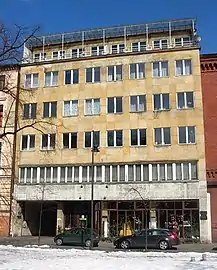 View from the square
View from the square Commemorative plaque for Wacław Gieburowski
Commemorative plaque for Wacław Gieburowski
High School Nr.1
Registered on Kuyavian-Pomeranian Voivodeship heritage list, Nr.A/264/1, 28 May 1991.[6]
Built in 1876–1877, by R. Oueissner: Neoclassicism.
Originally the seat of the German Royal Grammar School. In 1904–1905 a side wing was added. In 1920 the school was converted into State High School Classic, in 1938 it became the State High School and Middle School, and after World War II, High School in Bydgoszcz. The building is L-shaped, has two stories and an avant-corps.
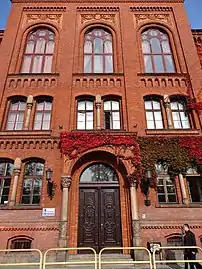 View from the square
View from the square Detail of the avant-corps
Detail of the avant-corps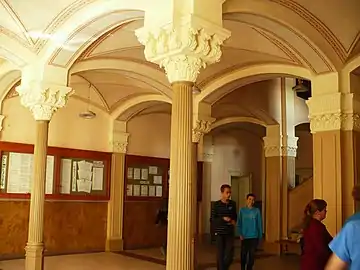 Detail of inside decoration
Detail of inside decoration
Freedom Monument
Built in 1945, by Jan Kossowski: Functionalism.
Monument to the fallen Soviet and Polish soldiers during the fighting for the liberation of the city in January 1945. It commemorates also the return of Bydgoszcz to Polish territory, on 20 January 1920. Design by Jan Kossowski as the "Monument of Gratitude to Soldiers of the Red Army". It was intended to be a temporary monument, pending the construction of more worthy project object, but this never happened. In 1990, it was renamed "Freedom Monument".[11]
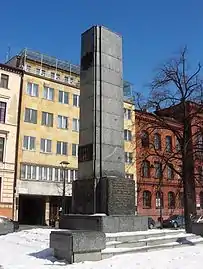 Freedom Monument
Freedom Monument one of the plaques on the monument, commemorating the return of Bydgoszcz to the Polish territory.
one of the plaques on the monument, commemorating the return of Bydgoszcz to the Polish territory.
Fountain "The Deluge"
Built in 1904, by Ferdinand Lepcke: Classicism.
One of the most original sculptures in Poland, it was an ornament in Bydgoszcz during the interwar period. Its designer was the Berlin sculptor Ferdinand Lepcke, also the author of Bydgoszcz Archer ("Łuczniczka"). The three-part sculpture depicted the people and animals trying to save themselves from the biblical flood. Water gushed fountains, reaching up to 6 m in height. In 1943, Nazis melted part of it for war purposes. Between 2004 and 2014, the original fountain was reconstructed by private fundings. Another fountain (built in 1906) of the same artist is still standing in the Rose Garden, Coburg.
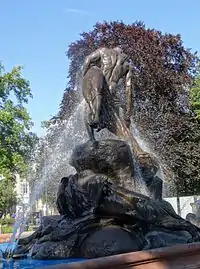 Global view of the fountain
Global view of the fountain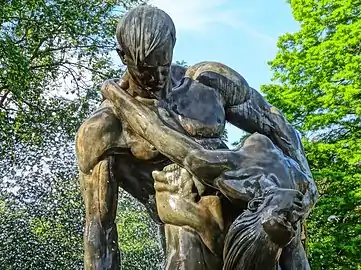 Detail of the characters
Detail of the characters%252C_zdj%C4%99cie_z_18.06.2014_r._(8).JPG.webp) Detail of the base
Detail of the base
Miscellaneous
On the square grows a planetree registered on the Polish Natural Monument list: this 346 cm trunk circumference tree stands beside St Peter's and St Paul's Church.[12]
In the immediate vicinity of High School Nr.1, at Gimnazjalna Street 2a, stands a neoclassical building built in 1865. During interwar was located there a private clinic for nervous diseases run by Dr. Króla.[13] It served as a military hospital during World War II, and from 1975 to 1993 it was a pulmonary diseases clinic with an X-ray laboratory.
Here also grows a Ginkgo biloba, listed as Polish Natural Monuments.[14]
See also
References
- 1 2 Bręczewska-Kulesza Daria, Derkowska-Kostkowska Bogna (2003). Ulica Gdańska. Przewodnik historyczny. Bydgoszcz.
{{cite book}}: CS1 maint: location missing publisher (link) - ↑ "Bydgoszcz-Bromberg" (in German). timediver.de. Retrieved 19 December 2018.
- 1 2 MATERIAlY DO DZIEJOW KULTURY I SZTUKI T4:BYDGOSZCZY I REGIONU, MAREK ROMANIUK-Pomnik konny cesarza Wilhelma I w Bydgoszczy
- ↑ Kulesza, Maciej (23 November 2015). "Historia najpiękniejszej bydgoskiej kamienicy". bydgoszcz.wyborcza.pl. Agora SA. Retrieved 3 September 2022.
- ↑ Kulesza, Maciej (4 August 2013). "Armata na pl. Wolności stała długo po wojnie". bydgoszcz.wyborcza.pl. Agora SA. Retrieved 3 August 2022.
- 1 2 3 4 5 zabytek|kujawsko-pomorskie|issued=1.03.2014
- ↑ Jastrzębska-Puzowska, Iwona (2000). Poglądy artystyczne i twórczość bydgoskiego architekta Fritza Weidnera. Materiały do Dziejow Kultury i Sztuki Bydgoszczy i Regionu zeszyt 5. Bydgoszcz: Pracownia Dokumentacji i Popularyzacji Zabytków Wojewódzkiego Ośrodka Kultury w Bydgoszczy. p. 37.
- ↑ nu-nu (2013). "Sztuka z dżinsami w tle". bydgoszcz24.pl. Retrieved 29 January 2017.
- ↑ bj (29 September 2015). "Jest moda na modernizm. Oto bydgoskie budynki w tym stylu". bydgoszcz.wyborcza.pl. Retrieved 29 January 2017.
- ↑ Wysocka, Agnieszka (2003). Działalność architektoniczna Jana Kossowskiego w Bydgoszczy w latach 1923-1939. Materiały do Dziejow Kultury i Sztuki Bydgoszczy i Regionu zeszyt 8. Bydgoszcz: Pracownia Dokumentacji i Popularyzacji Zabytków Wojewódzkiego Ośrodka Kultury w Bydgoszczy. p. 80.
- ↑ Błażejewski Krzysztof: Niewdzięczni bydgoszczanie. [w.] Kalendarz Bydgoski 2007
- ↑ Program Ochrony Środowiska dla miasta Bydgoszczy na lata 2013-2016 http://www.bip.um.bydgoszcz.pl/binary/721_tcm30-133312.pdf Archived 13 May 2014 at the Wayback Machine (34,2 MB)
- ↑ Książka, Adresowa (1929). "C.Dzial Medyczny". Miasta Bydgoszczy. Bydgoszcz. p. XXXII.
{{cite book}}: CS1 maint: location missing publisher (link) - ↑ Piotr Schutta "Uratują, ale tylko pół domu". Express Bydgoski 22 lipca 2014
Bibliography
- (in Polish) Daria Bręczewska-Kulesza, Bogna Derkowska-Kostkowska, A. Wysocka (2003). Ulica Gdańska. Przewodnik historyczny. Bydgoszcz: Wojewódzki Ośrodek Kultury w Bydgoszczy. ISBN 9788386970100.
{{cite book}}: CS1 maint: multiple names: authors list (link) - (in Polish) Derenda, Jerzy (2006). Piękna stara Bydgoszcz, t. I z serii Bydgoszcz, miasto na Kujawach. Bydgoszcz: warzystwo Miłośników Miasta Bydgoszczy. ISBN 9788391617816.
- (in Polish) Derenda, Jerzy (2008). Bydgoszcz w blasku symboli, t. II z serii Bydgoszcz, miasto na Kujawach. Bydgoszcz: warzystwo Miłośników Miasta Bydgoszczy. ISBN 9788391617816.
- (in Polish) Jastrzębska-Puzowska, Iwona. Od miasteczka do metropolii. Rozwój architektoniczny i urbanistyczny Bydgoszczy w latach 1850-1920. Bydgoszcz.
- (in Polish) Romaniuk, Marek (1999). Pomnik konny cesarza Wilhelma I w Bydgoszczy. Materiały do dziejów kultury i sztuki Bydgoszczy i regionu, z. 4. Bydgoszcz: Pracownia Dokumentacji i Popularyzacji Zabytków Wojewódzkiego Ośrodka Kultury w Bydgoszczy. pp. 11–14.
- (in Polish) Umiński, Janusz (1996). Bydgoszcz. Przewodnik. Bydgoszcz: Regionalny Oddział PTTK "Szlak Brdy".
- (in Polish) Urbański, Dawid (2012). Plac Wolności. Kalendarz Bydgoski. Bydgoszcz: Towarzystwo Miłośników Miasta Bydgoszczy.
